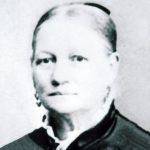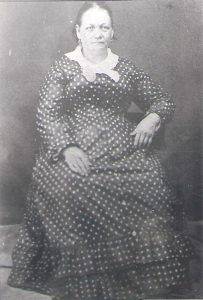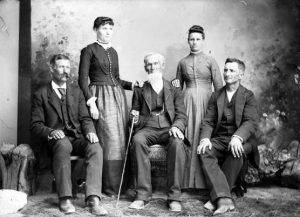
Rewritten in 1955 by Mrs. Ruth M. Killpack

ALMIRA MEHITABLE MEACHAM WHITING was born the 13th day of May, 1824 at Hopkinton, St. Lawrence, New York. She was the 4th of 11 children born to Stephen Peabody Meacham and Dorothy Maria Ransom of Rochester and Franklin, Vermont.
When the Saints were forced to leave their comfortable homes in Kirtland, Ohio, they took only bedding, clothing and their valuables with them, and went to Far West, Missouri. They were only there a short time when mobs of angry men came and drove them out and burned their homes. They were compelled to flee, and they went on to Lima to join the Saints there. A Mr. Morley was president of the branch. Here they could worship without so much persecution.
On January 3rd, 1845, Almira Meacham married Edwin Whiting, entering into the law of plural marriage as his second wife. Elizabeth Tillotson was the first wife. Almira respected her as the head of the household. Almira’s first husband was Andrew Palmer, by whom she had one son. Edwin and Almira had seven children born to them, 3 girls and 4 boys. At Lima, they were happy for several years in building up the town of Nauvoo, and the Nauvoo Temple.
In the year 1846, Edwin went on a mission to Pennsylvania and upon his return, he took up arms with his brethren to protect his property and the lives of his family. When they were compelled to move west, they went as far as Mt. Pisgah, Iowa. They stayed here long enough to prepare for the journey across the plains. While at this place, the cholera spread through the community taking Edwin’s father, mother, and daughter, Emily Jane. A great many were ill at the same time. A monument has been erected in memory of those who died at this place.
In April 1849, they started westward in Ezra F. Benson’s Company. The journey was long and tiring. They suffered from lack of proper food and clothing. Their cattle were stampeded and stolen by the Indians. After reaching the Black Hills, a heavy snow storm came and for three days they could not go on. Many of their cattle died. President Brigham Young sent men and teams with provisions to relieve their suffering. The company of Pioneers arrived in Salt Lake City late in the fall of 1849. They stayed here a short time until they were called with a few other families to go on and settle on the Sanpitch River, now known as Manti, Sanpete County, Utah. They honored the call of President Young and started on the journey south. They had to build the roads as they went and after three weeks of traveling and hardships, they arrived in the valley on the first day of December, 1849.
They had very little food or clothing with no feed for their cattle and no shelter. The weather was cold with four feet of snow on the ground. They made dugouts to live in on the south side of the stone quarry, beneath where the Manti Temple now stands. As the winter was long and hard, most of the cows and oxen died from cold and hunger. The Indians came and begged continually from their scanty supply of food. They had to divide in order to keep peace with them.
Brigham Young had promised to send supplies but none came. In February, Edwin and Orvil Cox started to Salt Lake on snowshoes, with a little parched corn for food, to report the condition of the people. Aid was immediately sent from Salt Lake to relieve the starving people. In the month of May of 1850, rattle snakes came out of the rocks in great numbers, invading the humble dugouts, coiled in the beds, cupboards and by the fire-place, yet no one was harmed.
For several years, very little was raised and they lived through hardship and poverty. Many times they had to dig sego lilies or gather wild greens for food. The Indians became so hostile that it was necessary to build a stone fort for the protection of the settlers. All of the LDS families lived inside of this wall in small log houses. The large gate was kept locked. Outside the Indians were howling night and day over their dead as many were dying of starvation. When the men went to the fields to work or to the canyon for wood, they carried their muzzle loading rifles with them. Among their experiences was the grasshopper war, all having to join in the fight in order to exterminate the pests.
Nothing was wasted in those days. Children went barefooted until cold weather came, and even the wood ashes were emptied into a large hopper and water poured on top of them to trickle through a small opening in the bottom of the hopper to be used as weak lye for the making of soft soap, and to soften the wash water. They raised broom corn and manufactured their own brooms. Sugar cane was grown to supply them with molasses (sorghum). The tops were used for chicken feed and seed. They raised flax which was treated and woven into cloth. Field corn was made into coarse corn meal, the whole kernel being used. The grain was cut by hand with a cradle, bound into bundles by hand and threshed by placing the bundles on a space of ground which had been smoothed off, then they would drive some of the oxen around and around over the bundles until the kernels of grain were shelled out. It was next winnowed out by hand with the assistance of the wind. The heads of wheat left in the fields by the reapers were gleaned and tied into small bundles by the children. The wool from their sheep was carded and spun by hand into yarn for stockings and mittens, and finer yarn for weaving into linsey sheets and clothing. The girls were all taught to card, spin, knit and weave. All the old clothing was woven into rugs and carpets.
On Christmas night, Grandmother (Almira Meacham Whiting) would make some dough sweetened with molasses. She would roll and cut this into dolls and animal shapes and fry them to a crispy brown. These with some parched corn and sticky molasses candy were used to fill the Christmas stockings hanging in a row on the crude stone mantle.
Almira was a splendid cook and seamstress. She made most of their clothing. When the men’s pants wore out on the seat and knees, she would “fox” them. This was done by cutting into an artistic shape a piece of buckskin or heavy cloth which she sewed onto the right side of the knees and seat of the pants. The pants were sometimes made of buckskin with fringe on the outside seam. If they were unfortunate enough to be out in a rain storm with these pants on, they would shrink up and would have to be stretched to the proper length.
The women wore home-spun dresses, shawls and hoods. Hats were made by making a braid out of oat straw and sewing and shaping it to fit the head. At that time it seemed unwise to go outside in the winter time without a hood or a small shawl over one’s head.
Almira M. Whiting was a midwife and a practical nurse. She was a good neighbor and spent many hours giving loving care to the sick. She was a beautiful woman with a kind and pleasant disposition. She was refined and very ambitious. Her husband, Edwin, was a nursery-man but the climate in Manti was too cold for raising fruit and flowers, so with the permission of Brigham Young, he moved his large family to Springville where he continued his business and then they moved onto the bench which is now Mapleton, Utah.
Edwin Whiting died in Mapleton on the 8th of December, 1890 age 81 and Almira M. Meacham Whiting later went to San Bernardino, California where she died 1 October, 1898, age 74.
Rewritten in April 1955 by: Mrs. Ruth M. Killpack, 939 West 5th North, Provo, Utah. A Great-Great Granddaughter-in-law of Almira M. Meacham Whiting. Source: Lovell Killpack, Orem, Utah



No comment yet, add your voice below!